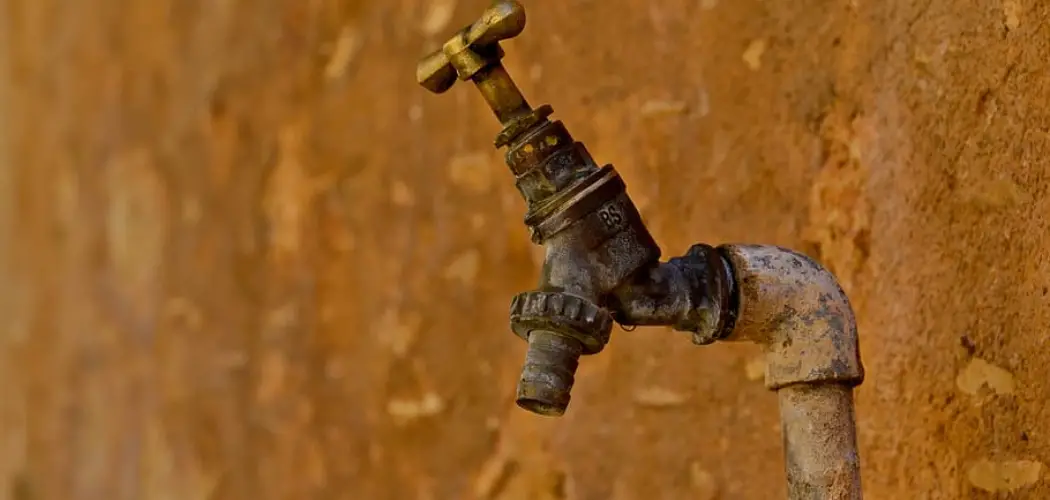Are you dealing with unsightly calcium deposits on your faucets? Craving to restore that shiny, new appearance to your kitchen or bathroom fixtures? Your quest ends here with our definitive guide: “How to Remove Calcium Buildup on Faucets.” This blog post will walk you through the process, providing clear, step-by-step instructions to remove those stubborn mineral blemishes effectively.
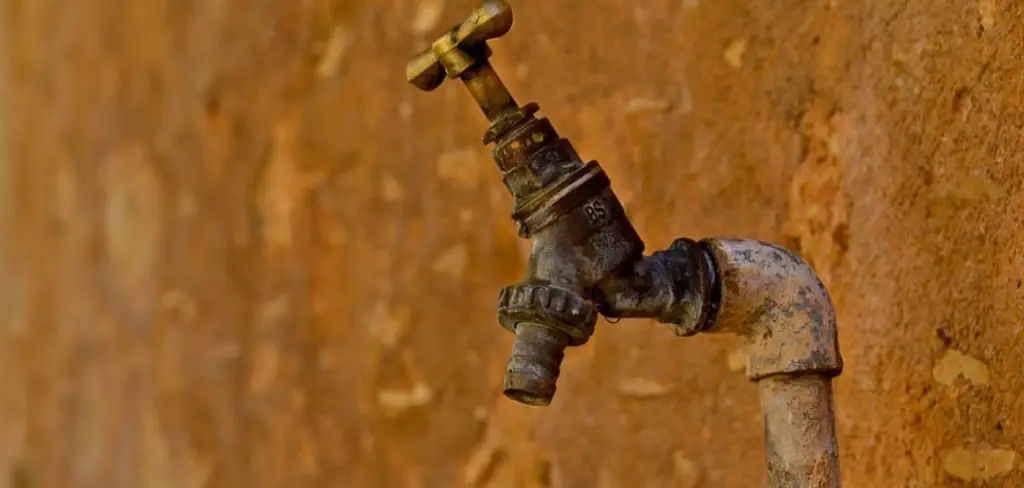
The right knowledge and a bit of elbow grease can transform your calcium-coated faucet into a gleaming centerpiece. Read on to discover how to tackle this common household issue and maintain your fixtures in pristine condition.
Understanding Calcium Buildup
What Is Calcium Buildup?
Calcium buildup, also known as limescale, occurs when water containing dissolved calcium bicarbonate heats up, causing it to precipitate out to form solid calcium carbonate deposits. Over time, these hard, chalky mineral deposits accumulate on surfaces – especially on faucets where water regularly flows.
Why Does It Occur?
Calcium buildup commonly occurs due to the presence of hard water, which is rich in minerals such as calcium and magnesium. When the hard water evaporates or is heated, the minerals are left behind, causing buildup on surfaces the water was in contact with. Consequently, faucets and other plumbing fixtures are prone to limescale because they are regularly in contact with hard water.
Can You Remove Calcium Buildup on Faucets?
Calcium buildup on faucets is a common annoyance in many households. Not only can it look unsightly, but it can also impede water flow and even cause damage to your fixtures over time. Thankfully, there are several methods to remove calcium buildup from your faucets.
Natural solutions can effectively dissolve the mineral deposits from vinegar to baking soda without damaging the faucet’s surface. For more stubborn buildup, a commercial descaling product can be used. Regular cleaning and maintenance can also help prevent buildup from occurring in the first place so that you can enjoy a sparkling clean and fully functional faucet.
Why Should You Remove Calcium Buildup on Faucets?
Are you tired of your once-shiny faucets now looking dull and worn? The culprit may be calcium buildup caused by hard water deposits. Not only does this unsightly buildup make your fixtures look aged, but it can also affect the functionality of your faucets.
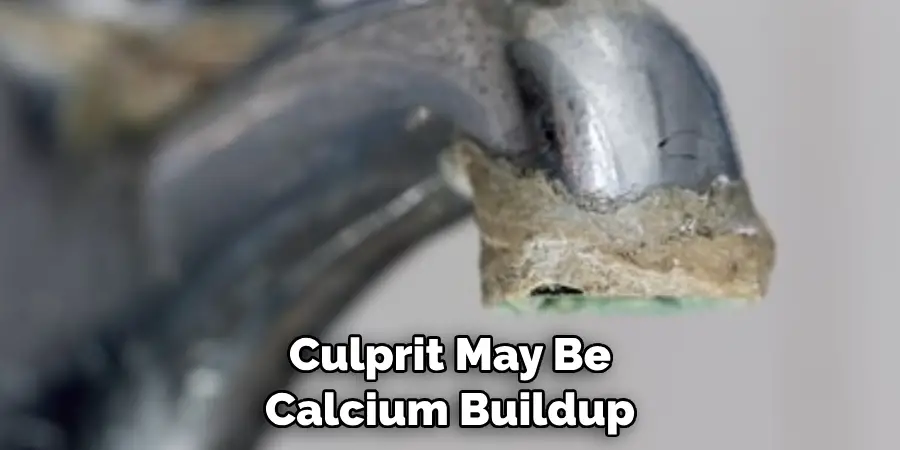
Calcium deposits can clog aerators and reduce water flow, leading to wasted time and frustratingly low water pressures. In addition, leaving hard water buildup untreated can result in the need for costly repairs down the road. By removing calcium buildup on your faucets, you can improve the appearance of your fixtures and ensure their longevity and optimal performance.
Tools and Materials You’ll Need
To effectively remove calcium buildup on your faucets, you’ll require the following items:
- White vinegar
- A spray bottle
- A toothbrush or non-scratch scrubbing sponge
- Rubber gloves
- Eye protection
- Soft cloth or towel
- Baking soda (optional)
- Toothpicks (optional for tiny crevices)
Safety Precautions
When handling chemicals and equipment, it’s essential to prioritize safety. Always put on your rubber gloves and eye protection before starting the process. If you’re sensitive to smells, consider wearing a mask, as vinegar has a strong odor. Ensure your work area is well-ventilated. When using the toothbrush or sponge to scrub, do so gently to avoid damaging your faucet’s finish.
How to Remove Calcium Buildup on Faucets – in 7 Easy Ways
1. Vinegar Solution
A vinegar solution is one of the most effective ways to remove calcium buildup on a faucet. Pour some vinegar into a plastic bag and wrap it around your faucet. Ensure that the vinegar comes in contact with the affected area and leave it to soak for about 30 minutes. After that, remove the bag and use a scrub brush or toothbrush to clean the area. You can rinse it off with water and repeat the process if needed. Vinegar is a natural cleaner that breaks down calcium deposits and leaves your faucet looking brand new.
2. Lime-Away
Lime-Away is another great option when it comes to removing calcium buildup on faucets. Lime-Away is a stronger solution, particularly designed for hard water issues. Simply apply the solution to your faucet with a sponge or cloth, leave it on for a few minutes, then use a scrub brush to clean the buildup. Make sure to rinse it thoroughly with water and dry it off afterward. Lime-Away is highly effective, and you will be amazed at the difference it makes.
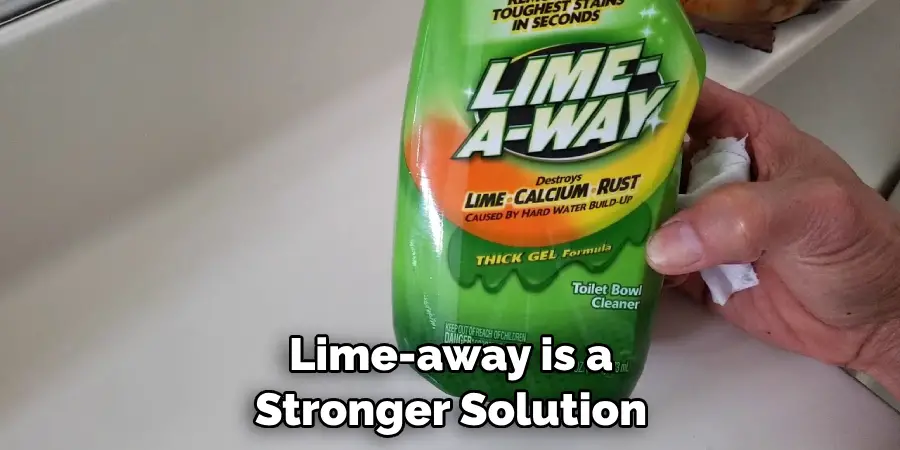
3. Baking Soda and Lemon Juice
A baking soda and lemon juice mixture is another great remedy for calcium buildup on faucets. Mix the two substances together until they form a paste. Smear the paste over the affected areas and leave it for 15-20 minutes. Use a brush to scrub the buildup off, and rinse your faucet thoroughly with water. The acid in lemon juice helps dissolve the calcium buildup, while the baking soda acts as an abrasive to scrub it away.
4. Use a Toothbrush
If you are dealing with small areas of calcium buildup on your faucet, a toothbrush will come in handy. Simply put some toothpaste onto your toothbrush and use it to scrub the affected area. The abrasiveness of the toothpaste will help clean out the deposits while leaving your faucet looking fresh and shiny. It’s a quick and easy way to get rid of the most stubborn buildup.
5. Regular Cleaning
Prevention is always better than cure, and regular cleaning is key when it comes to calcium buildup on faucets. Make it a habit to monitor your faucets regularly and clean them with soap and water to prevent buildup. This way, you will not have to deal with stubborn buildup that requires harsh cleaning solutions in the future.
6. Boiling Water
If your calcium buildup is more stubborn than usual, you can try boiling water to dissolve it. Boil a pot of water and pour the hot liquid directly onto the faucet. The heat will help weaken the calcium deposits, making them easier to clean with a scrub brush or toothbrush. Just make sure to rinse your faucet with cold water afterward.
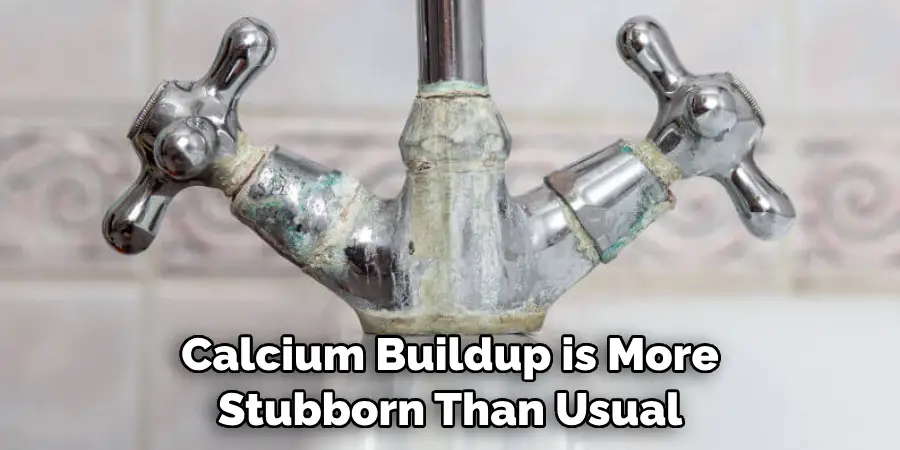
7. Professional Cleaning
For the most stubborn calcium buildup, it is best to leave it in the hands of professionals. A professional cleaning service will be able to remove hard-to-remove calcium deposits from your faucets without any hassle. This is a great option if you don’t have the time or energy to clean your faucet yourself.
That’s it! You’ve now learned how to remove calcium buildup on faucets. With these tips and tricks, you will be able to keep your faucets looking shiny and new all year round! So get cleaning and make sure to stay on top of it.
5 Considerations Things When You Need to Remove Calcium Buildup on Faucets
1. The Type of Faucet.
There are several types of faucets, and each one may require a different method for removing calcium buildup. For example, cartridge faucets have removable cartridges that can be soaked in vinegar or another acidic solution. Ball faucets have a ball controlling the flow of water, which can also be removed and soaked in vinegar. Compression faucets have two handles, one for hot water and one for cold water, and these handles can be unscrewed and soaked in vinegar.
2. The Severity of The Calcium Buildup.
If the calcium buildup is severe, you may need to use a more aggressive method, such as sanding or scraping. However, if the calcium buildup is not too bad, you may be able to remove it with a less aggressive method, such as soaking in vinegar or using a commercial cleaner designed specifically for removing calcium buildup.
3. The Material of The Faucet.
The material of the faucet will also play a role in determining the best way to remove calcium buildup. For example, stainless steel faucets can usually be cleaned with vinegar or a commercial cleaner, but brass or bronze faucets may require sanding or scraping.
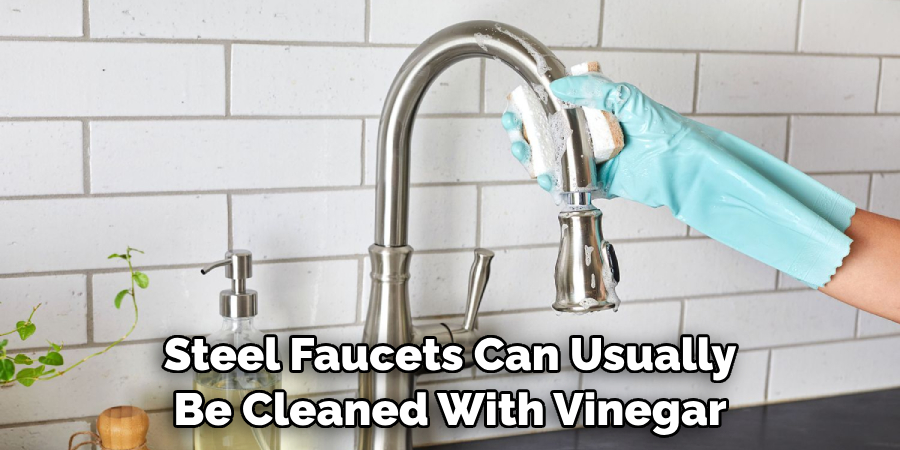
4. The Finish of The Faucet.
Some faucets have a finish that certain cleaning methods can damage. For example, brushed nickel faucets should not be cleaned with abrasive cleaners, which can damage the brushed finish. Similarly, oil-rubbed bronze faucets should not be cleaned with harsh chemicals, which can damage the finish.
5. The Location of The Calcium Buildup.
The location of the calcium buildup will also affect the best way to remove it. For example, if the calcium buildup is on the spout of the faucet, you may need to use a toothbrush or other small brush to reach it. However, if the calcium buildup is on the base of the faucet, you may be able to soak it in vinegar or another acidic solution.
By considering all of these considerations, you can ensure that the best method is chosen for removing calcium buildup from your faucet. This will help to keep the faucet looking great and functioning properly!
Benefits of Remove Calcium Buildup on Faucets
When it comes to keeping your home looking clean and fresh, few things are more important than maintaining your faucets. After all, they’re one of the most frequently used fixtures in any house, and it can be frustrating to see them start to look dingy or discolored over time. One common issue that many homeowners face is calcium buildup on their faucets, which can make them look unsightly, reducing water flow and making it harder to clean.
Fortunately, there are plenty of benefits to removing this buildup, including extended faucet life, improved water quality, and a more attractive appearance for your bathroom or kitchen. So, if you’re looking for an easy way to keep your home looking its best, consider investing in a good calcium remover and giving those faucets the care they deserve.
Some Common Mistakes People Make When Trying to Remove Calcium Buildup on Faucets
Calcium buildup on faucets can be an unsightly and frustrating problem to deal with. Many people try to remove it using different methods, but unfortunately, some of these methods can do more harm than good. One common mistake people make is using abrasive materials or harsh chemicals that can scratch or damage the faucet’s surface. This not only ruins the appearance of the faucet but can also weaken it structurally over time.
Another mistake is not cleaning the faucet regularly, which allows the calcium buildup to accumulate and harden, making removing it even more difficult. It’s important to use gentle, non-abrasive cleaners and clean your faucet regularly to keep it looking and functioning at its best.
Preventative Measures to Avoid Calcium Buildup
While removing calcium buildup on faucets is a relatively simple process, it may be time-consuming and inconvenient to have to do so frequently. To avoid the hassle of constantly removing buildup, it is important to take preventative measures. Here are a few tips to help avoid calcium buildup on your faucets:
Use a Water Softener:
Hard water is a major culprit for calcium buildup on faucets. Installing a water softener in your home can greatly reduce the amount of minerals and other deposits that can cause buildup on your faucets.
Clean Your Faucets Regularly:
Regularly cleaning your faucets with a mild soap or vinegar solution can help prevent calcium buildup. This will also keep your faucets looking shiny and new.
Use a Water Filter:
If you don’t have access to a water softener, using a water filter on your faucet can also help reduce the amount of minerals and deposits that can cause buildup.
Wipe Down Your Faucets After Each Use:
After using your faucet, be sure to wipe it dry with a soft cloth. This will prevent water from sitting on the surface and causing mineral buildup.
Soak in Vinegar Solution:
If you notice a small amount of buildup on your faucet, soak a cloth in white vinegar and wrap it around the affected area for about an hour. This will help dissolve the calcium and make it easier to remove.
Tips and Tricks for Maintaining Clean Faucets in the Future
Keep Up With Regular Cleaning
To keep your faucets looking their best, it is important to clean them regularly. This can be as simple as wiping down the faucet with a damp cloth or rinsing with mild soap and water. Doing this once a week will help prevent calcium buildup from accumulating over time.
Use a Mild Cleaner
When cleaning your faucet, it is important to use a mild cleaner that won’t damage the finish. Some common household items, such as vinegar or lemon juice, can work well for this purpose. Make sure to rinse the faucet thoroughly after each use and dry it with a soft cloth.
Avoid Abrasive Cleaners
Abrasive cleaners such as steel wool or scouring pads can scratch and damage the finish of your faucet. These types of cleaners should be avoided, especially with softer finishes such as brushed nickel or oil-rubbed bronze. Stick to mild, non-abrasive cleaning solutions for best results.
Wipe Away Water Spots
Water spots can accumulate on faucets over time, leaving behind stubborn streaks and discoloration. To avoid this, wipe down the faucet after each use with a clean, dry cloth. This will help keep your faucet looking its best in between regular cleaning sessions.
Avoid Using Harsh Chemicals
Harsh chemicals such as bleach or ammonia can cause discoloration and damage some finishes. Be sure to use mild cleaners and avoid using these types of products on your faucet.
Cover Your Faucet When Not in Use
If you’re not going to be using your faucet for a few days, it’s a good idea to cover it with a cloth or paper towel. This will keep dust and other debris from settling onto the faucet surface, making it easier to clean when you’re ready to use it again.
Avoid Over-Tightening The Hardware
When installing or replacing your faucet, it is important to avoid over-tightening the hardware. Doing so can cause damage to the material of the faucet and make it more prone to calcium buildup.
Invest in a High-Quality Faucet
Finally, it’s important to invest in a high-quality faucet that can withstand regular use and cleaning. Look for options with durable finishes, such as brushed nickel or oil-rubbed bronze, which are less likely to wear down over time. Doing so will help ensure your faucet looks great and functions properly for years to come!
It’s clear that taking some simple steps before calcium buildup becomes a problem can help you extend the life of your faucet and keep it in top condition. By following the tips above, you can ensure that your faucets stay looking great and functioning properly for years to come!
And if calcium buildup does occur, remember that there are plenty of effective methods for removing it safely and quickly. With a little bit of effort and patience, you can give your home’s faucets the care they deserve and keep them looking their best.
Preventing Hard Water Stains on Other Surfaces
Aside from faucets, hard water can also cause unsightly stains and buildup on other surfaces in your home. These include showerheads, toilets, sinks, and even dishes and glasses. Here are some tips for preventing hard water stains on these surfaces:
Use a Water Softener or Filter
As mentioned earlier, installing a water softener or using a water filter can greatly reduce the amount of minerals and deposits in your water. This will help prevent calcium buildup not only on faucets but also on other surfaces.
Clean Regularly
Like with faucets, regular cleaning is key to preventing hard water stains on other surfaces. Be sure to clean your showerhead, toilet, sink, and dishes regularly with mild soap or a vinegar solution.
Soak in Vinegar Solution
For tougher stains on surfaces such as showerheads or toilets, soaking them in a vinegar solution can help dissolve the buildup and make it easier to remove.
Use a Water Spot Remover
If you’re dealing with tough water spots on dishes or glasses, using a water spot remover can help eliminate them. These products are specifically designed to break down mineral deposits and make your dishes look shiny and new.
Wipe Dry
As with faucets, wiping surfaces dry after use can help prevent hard water stains from forming. This is especially important for glassware and dishes that are more prone to water spots.
Invest in High-Quality Surfaces
Just like faucets, investing in high-quality surfaces such as showerheads and sinks can greatly reduce the likelihood of hard water stains. Look for options with durable finishes that are easy to clean and maintain.
Consider Using a Stain-Resistant Coating
There are also products available that can provide a protective coating to surfaces, making them more resistant to hard water stains. These can be especially helpful for highly-used areas such as shower walls or sink basins.
By following these tips and investing in the right products and surfaces, you can keep your entire home looking clean and free of hard water stains. Don’t let the effects of hard water take over – be proactive in preventing and removing buildup before it becomes a problem. With these simple steps, you can maintain a beautiful, functional home for years to come.
The Negative Effects of Hard Water on Appliances
Hard water, rich in minerals like calcium and magnesium, can wreak havoc on household appliances such as dishwashers and washing machines, leading to a decrease in efficiency and lifespan. The minerals in hard water can be deposited on the internal components of these appliances, forming a layer of scale. This build-up not only affects the appliance’s operational efficiency, causing it to work harder and consume more energy but also leads to premature wear and tear.
Preventing Damage with Water Softeners or Filters
To mitigate the damaging effects of hard water, the use of water softeners or filters is highly recommended. Water softeners work by swapping the minerals in hard water with sodium ions, preventing scale formation in the appliances. On the other hand, filters remove these minerals, purifying the water. Both these solutions can significantly enhance the longevity of your appliances, boost their performance, and result in energy savings. Regular maintenance of these water treatment systems is essential to ensure their optimal functioning over time. With this proactive approach, you can protect your household appliances from the damaging effects of hard water.
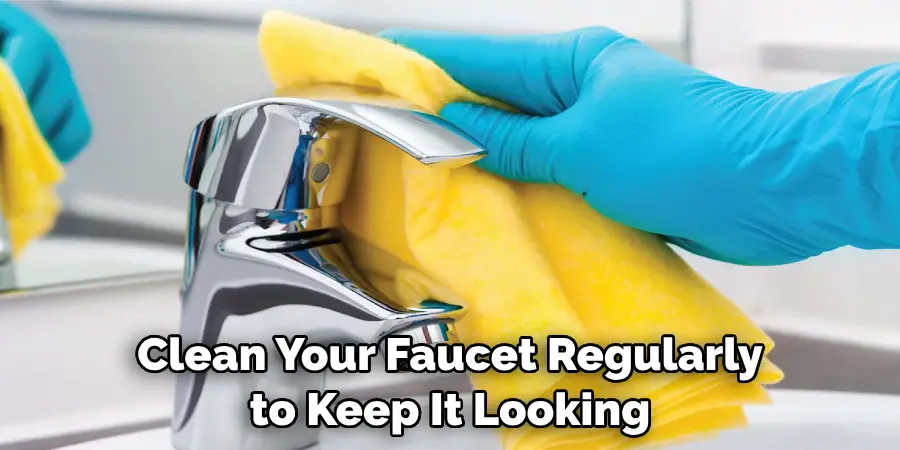
Conclusion
Calcium buildup on faucets is an easy problem to solve when you know the right techniques to use. This blog has shown you some of the most effective ways to remove calcium buildup on faucets, from the use of vinegar solutions and Lime-Away to baking soda and lemon juice.
By incorporating these tips into your cleaning routine, you can prevent and remove calcium buildup before it becomes a major issue. Keep your faucets shiny and functional with these helpful tips! Thanks for reading our post about how to remove calcium buildup on faucets.

